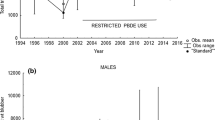Abstract
Concentrations of polybrominated diphenyl ethers (PBDEs) in Baltic Sea herring Clupea harengus membras L. collected from Estonian coastal waters are reported. In the period 2006–2008 the total PBDE concentrations (ΣPBDE, sum of 15 congeners) in Baltic herring varied between 0.57 and 4.08 ng g−1 fresh weight. Highest ΣPBDE concentrations were in a 2007 sample from the mouth of the Gulf of Finland and in a 2007 sample from the Gulf of Riga. The former contained a high concentration of BDE 209 (16.3 ng g−1) and in the latter this congener was the second most abundant. It is not clear whether the BDE 209 concentration in the Gulf of Finland sample is not an artefact and this value was not included in the above range. The PBDE concentrations increased with the age of herring are similar to those reported in [1] in fish collected in the Bothnian Sea in 2002 and did not increase between 2002 and 2008. The majority of concentrations in herring from the Estonian coastal zone was <1.0 ng g−1 fresh weight. The PBDE congener profiles varied regionally as well as with age of the fish. The main congeners were mostly the BDEs 47, 99, and 100. Some of the variations probably caused by measurement artefacts.
Similar content being viewed by others
References
Parmanne, R., Hallikainen, A., Isosaari, P., Kiviranta, H., Koistinen, J., Laine, O., Rantakokko, P., Vuorinen, P.J., and Vartiainen, T., Mar. Pollut. Bull., 2006, no. 52, 149.
Roots, O., Ekologicheskaya Khimia (Ecological Chemistry), 2008, vol. 7, no. 1, p. 22.
Roots, O., Kiviranta, H., and Rantakokko, P., Organohalogen Comp., 2007, no. 69, p. 2339.
Jaward, F.M., Farrar, N.J., Harner, T., Sweetman, A.J., and Jones, K.C., Environ. Sci. Technol., 2004, no. 38, p. 34.
Gioia, R., Sweetman, A.J., and Jones K.C., Environ. Sci. Technol., 2007, no. 41, p. 2165.
Roots, O. and Sweetman, A., Oil Shale, 2007, no. 24, p. 483.
Sajwan, K., Kumar, K., Roots, O., Kõlli, R., Mowery, H., and Loganathan, P., Organohalogen Comp., 2008, vol. 70, p. 2474.
Guvenius, D., Doctoral theses, Karolinska Institute, Stockholm, Sweden, 2002.
Roots, O. and Zitko, V., Environ. Sci. & Pollut. Res., 2004, no. 3, p. 186–193.
Assmuth, T. and Jalonen, P., Risks and management of dioxins and dioxin-like compounds in Baltic Sea fish: An integrated assessment. Copenhagen, Nordic Council of Ministers. TemaNord, Copenhagen, Denmark: APN, 2005.
Bignert, A., Sundqvist, K., and Wiberg, K., in Proceedings of Dioxin, 2005/ISPAC 20, Toronto, Canada, 2005, pp. 1403–1405.
Pandelova, M., Henkelmann, B., Roots, O., Simm, M., Järv, L., Benfenati, E., and Schramm, KW., Chemosphere, 2008, no. 71, p. 369.
Schelepchikov, A.A., Shenderyuk, V.V., Brodsky, E.S., Feschin, D., Baholdina, L.P., and Gorogankin, S.K., Environ. Toxicol. Pharmacol., 2008, no. 25, p. 136.
Roots, O., Zitko, V., Kiviranta, H., and Rantakokko, P., Arh. Hig. Rada Toksikol., 2008, no. 59, p. 153.
Kiviranta, H., Ovaskainen, M.L., and Vartiainen, T., Environ. Int., 2004, no. 30, p. 923.
Eigenvector Research, Inc., www.eigenvector.com
The Mathworks, Inc., www.mathworks.com
von Bertalanffy, L., Hum. Biol., 1938, no. 10, p. 181.
Roots, O., AMBIO, 1992, no. XXI, p. 321.
Jenssen, B.M., Sormo, E.G., Bæk, K., Bytingsvik, J., Gaustad, H., Ruus, A., and Skaare, J.U., Environ. Health Perspect., 2007, no. 115 (suppl. 1), p. 35.
Agrell, C., Larsson, P., Okla, L., Bremle, G., Johansson, N., Klavins, M., Roots, O., and Zelechowska, A., in Ecological Studies, Eds. Wulff, F., Rahm, L., Larsson, P., Springer Verlag, 2001, 148, pp. 149–175.
Kierkegaard, A., Doctoral theses, Stockholm University, Sweden, 2007.
Legler, J. and Brouwer, A., Environ. Int., 2003, no. 29, p. 879.
http://ec.europa.eu/fisheries/cfp/management_resources/baltic_note/baltic_note_2_1_en.htm
Author information
Authors and Affiliations
Additional information
Original Russian Text © O. Roots, V. Zitko, H. Kiviranta, P. Rantakokko, P. Ruokojärvi, 2010, published in Ekologicheskaya Khimiya, 2010, Vol. 19, No 2, pp. 75–97.
Ott Roots, Cand. Sci. (Chem.), Chief Scientist/Institute Director, Estonian Environmental Research Institute, under Estonian Environmental Research centre, Tallinn, Estonia; Faculty of Science and Technology, Estonian Marine Institute, University of Tartu, Estonia. Scientific area of focus: bio-, geosciences and environment, research on substances hazardous to the environment; special interest persistent organic pollutants, as PCB, PCDD/Fs, DL-PCBs, HCB, HCH, DDT, PBDE, etc., distribution in the environment and environmental monitoring.
Vladimir Zitko, Cand. Sci. (Chem.), Consultant
Hannu Kiviranta, Prof., Ph.D., Senior Researcher, Head of the Chemical Exposure Unit, National Institute for Health and Welfare (THL), Department of Environmental Health, Neulanen Research Centre, Kuopio, Finland. Scientific area of focus: environmental health as a large area, especially, specific exposure assessment of the Finnish general population and specific subgroups to harmful compounds; chemical analyses of dioxins (PCDD/Fs) and PCBs.
Panu Rantakokko, Dr., Ph.D., Senior Researcher, National Institute for Health and Welfare (THL), Department of Environmental Health, Neulanen Research Centre, Kuopio, Finland. Scientific area of focus: environmental health as a large area, especially, specific exposure assessment of the Finnish general population and specific subgroups to harmful compounds; chemical analyses of dioxins (PCDD/Fs) and PCBs.
Päivi Ruokojärvi, Dr., Ph.D., Senior Researcher, Quality manager National Institute for Health and Welfare (THL), Department of Environmental Health, Neulanen Research Centre, Kuopio, Finland. Scientific area of focus: environmental health as a large area, especially, specific exposure assessment of the Finnish general population and specific subgroups to harmful compounds; chemical analyses of dioxins (PCDD/Fs) and PCBs.
Rights and permissions
About this article
Cite this article
Roots, O., Zitko, V., Kiviranta, H. et al. Polybrominated diphenyl ethers in Baltic herring from Estonian waters, 2006–2008. Russ J Gen Chem 80, 2721–2730 (2010). https://doi.org/10.1134/S1070363210130050
Received:
Published:
Issue Date:
DOI: https://doi.org/10.1134/S1070363210130050




